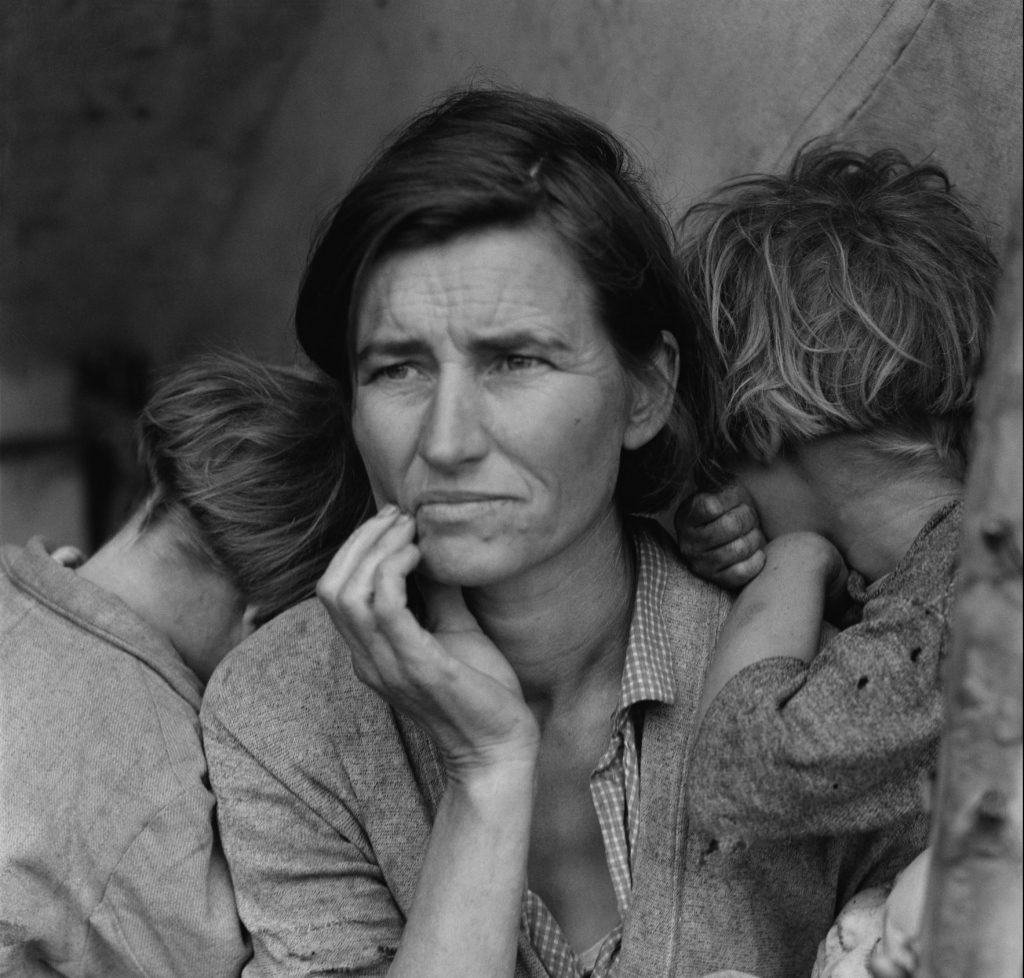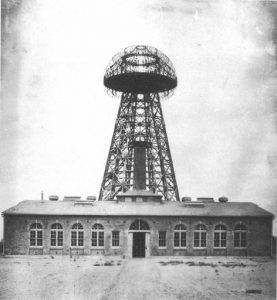What can a single image possibly say about our complex world? Of course, one picture can’t possibly capture everything. All of the tragedy and despair or all of the celebrations and joyful moments can hardly be captured in a million pictures. So, what difference can one picture really make? Documentary photographer, Dorothea Lange, set out with a simple goal in mind: to document the lives of the ordinary people in the world around her. In doing so, she inadvertently brought about drastic change through the increase of awareness of poverty and the conditions people were forced to endure. Lange influenced millions through the use of one single picture, and, that influence has and will continue for decades in the future.1
Lange found her life’s work and passion as a photographer in the 1930s, following the path of a common photographer in capturing people’s portraits and selling them to make a profit. While she enjoyed her work and was obviously very skilled, she always thought of herself as more of a historian than a true artist. As her career in portraiture continued, she improved her skills and came to open up a studio of her own in San Francisco, California. Here, she continued to perfect her craft, and she shared her talent with those among the wealthier classes of her society. It didn’t take long, however, for her to realize that her picture-taking skills could be used for much bigger, much greater, and overall, much more important things.2
In the midst of her successful portrait-focused career, the Great Depression struck and ravaged the lives of Americans far and wide. Lange, who originally, “would have thought it enough to take a picture of a man, nothing more,” quickly came to readjust her mindset upon seeing the pain in the world around her, and instead, decided that she “wanted to take a picture of a man as he stood in the world.”3 In 1933, a time in American history categorized by increasing tension and unbearable poverty in the lives of the average worker, Lange made what would come to be a life-changing decision: a drastic change in her creative mindset from elegant portraits to exposing the conditions of poverty. This single change in her life led her to become, undoubtedly, one of the most influential documentary photographers of the Great Depression.4

In May of 1935, with her newfound purpose of documenting the suffering around her, Lange became an employee of the Resettlement Administration (RA), later known as the Farm Security Administration (FSA). The goal of the RA was to bring to light the struggles of rural poverty in the country through the use of photographs. They found that sharing the conditions and hardships of life through photographs was much more impactful than any written reports, because the audience could see situations with their own eyes, which they may not have ever had the chance to see. The RA used this method of documentary photography because they recognized how powerful it could be and they needed to gain support for their projects. Lange’s job with the RA was demanding and required her to travel across the country to places that many had never heard of or even knew existed at all.5 Needless to say, she completed meaningful work and had many adventures throughout her time with the RA.

On one such adventure, on a rainy day in March of 1936, Lange had just finished another one of her photography excursions in California, and had packed up all of her equipment and supplies to begin her more than seven-hour drive home to her family. The drive started off dull and uneventful as she pushed ahead in the pouring rain. Occasionally, there were other cars and signs on the side of the road, but nothing out of the ordinary for the small San Luis Obispo County road. “PEA-PICKERS CAMP” one sign read. She considered stopping, thinking she would document more of the harsh conditions in the rural area, but instead, decided against it, knowing she still had a long trip ahead of her. While the sign and the camp became further and further behind her, they never left the forefront of her mind.
As she drove on, she thought to herself, questioning what could have been so special about that camp. It was just another pea-pickers camp, like the others she had already seen and taken pictures of. Why should she care about another one? It couldn’t possibly be that different from the ones she’d already seen. She would probably just drive in to find the same suffering and poverty she’d seen at the others. What difference would it make if she just drove past this one camp? Nobody even knew it existed anyway, so it wouldn’t make a difference, right? After getting lost in this inner argument, trying in every way possible to convince herself why she should not turn around, Lange almost unconsciously made a U-turn twenty miles past the sign and began to drive back to the camp.6
Upon reaching the camp that she had almost convinced herself to leave behind, Lange was drawn to one woman in particular. She didn’t ask for the woman’s name, or anything about her history or how she came to work at the pea-picker camp. Lange simply saw this kind of information as irrelevant to achieving her goal, which was to highlight the horrendous conditions and intense poverty of the Great Depression. While she didn’t learn much about the woman, she did learn that she was a mother of seven, living in a makeshift tent surviving mostly on frozen vegetables and small birds. The woman and Lange talked briefly, and then Lange proceeded to take a total of five pictures of the mother and several of her children, later saying, “There she sat in that lean-to tent with her children huddled around her, and seemed to know that my pictures might help her, and so she helped me. There was a sort of equality about it.” After spending a brief ten minutes at the camp, with the limited amount of information Lange had on her subjects, and a grand total of five pictures, Lange once again packed up her supplies and continued on her long trip back home.7

Lange’s intuition to turn her car around that day must have been very powerful. Deep down inside she must have known that her choice to go on or to turn around would make a profound difference in her story and in the lives of millions of those struggling around the world. That one, ten minute stop and those five pictures that Lange almost didn’t get the chance to take, later came to shape her entire career. Those pictures are the reason she is remembered to this day, the most famous being titled “Migrant Mother.” This image depicts the mother of seven that Lange met at the pea-picker camp, staring far off into the distance, seemingly lost in thought and isolated, even as she was surrounded by several of her children. Most, if not all, of Lange’s pictures had a recurring theme of separation from society, with an emphasis on the struggling classes and the pain that they had to endure on a daily basis.8 Lange’s “Migrant Mother,” however, displayed this theme so well that it became a symbol of the Great Depression as a whole. The image became an icon of the Great Depression and people in different cultures even began to replicate it to make it relevant to themselves. One picture gave the mother and children Spanish features, while still another gave them black features.9 Her work was so moving that it mirrored the isolated feelings of numerous cultures and became universally accepted and used to try and changed the way these people were being treated. Lange’s “Migrant Mother” slowly became one of the most recognizable and copied images in history.10
- Encyclopedia of the Great Depression, 2004, s.v. “Lange, Dorothea,” by Linda Gordon. ↵
- Allison McNeill et al., Great Depression and New Deal Biographies (Great Depression and the New Deal Reference Library: vol. 2: Biographies, UXL, 2003), 141-142. ↵
- David P. Peeler, Hope among Us Yet: Social Criticism and Social Solace in Depression America (Athens, Georgia: University of Georgia Press, 1987), 62. ↵
- Encyclopedia of the Great Depression, 2004, s.v. “Lange, Dorothea,” by Ed. Robert S. McElvaine. ↵
- Allison McNeill et al., Great Depression and New Deal Biographies, (Great Depression and the New Deal Reference Library: vol. 2: Biographies, UXL, 2003), 144-146. ↵
- Milton Meltzer, Dorothea Lange: A Photographer’s Life (New York, NY: Farrat, Straus & Giroux, 1978), 132-133. ↵
- Dorothea Lange, “The Assignment I’ll Never Forget: Migrant Mother,” Popular Photography February 1960, 1-2. ↵
- Melissa A. McEuen, Seeing America: Women Photographers between the Wars (Kentucky: The University Press of Kentucky, 2000), 110. ↵
- Judith Fryer Davidov, Women’s Camera Work: Self/Body/Other in American Visual Culture. (Durham, North Carolina: Duke University Press, 1998), 5-6. ↵
- Lawrence W. Levine, “The Historian and the Icon: Photography and the History of the American People in the 1930s and 1940s,” In Documenting America, 1935–1943, (Berkley: University of California Press, 1988), 16. ↵



140 comments
Steven Hale
I think one of the incredible things about these photographs is that we do not even need to see the background or environments these people are in to grasp the weight of their situations. We can tell how exhausted and worn down they feel just by seeing the darkness around their eyes and the lines on their faces. Lange was really able to capture the effects of poverty, putting a human face to the problem.
Jose Sanchez
I had seen the images but never knew Dorothea Lange was the person behind them. These pictures are amazing and brought much needed attention to the desperate situation people found themselves in. It was very selfless of Lange to decide to photograph and document the plight of those suffering rather than sticking to photographing the wealthy. Her photographs are an example of how strong photographs can be.
Marina Castro
Interesting article! Congratulations Pamela Callahan for the nomination of Best Use of Images on your article. The images you used on your article create a great impact on the reader. This is the type of article that is incomplete without its images. The topic you chose to write about is a very sad one. You were able to convey very well the story with an appropriate mood.
Cynthia Rodriguez
This was my first time reading about Dorothea Lange, but I think it is cool that she made it her goal to document the lives of ordinary people. She could have taken pictures of anything she wanted, but she chose to spend her time photographing people in their everyday lives. I think it is incredible that her pictures brought awareness to poverty. She was able to capture the way people were living during the Great Depression. I also think it is interesting that Lange had such a strong gut feeling to turn her car around and take picture in the pea-picker camp. It was at this camp that she shot her most famous image. This was a very engaging article and I enjoyed learning about Lange and her photography.
Lyzette Flores
Although I had never seen this photographs, a picture is worth a thousand words and I am pretty sure we can all agree with that. These photographs captured were so powerful that more than 50 years later they are still talked about. I bet Dorothea Lange was so glad she went back and did not continue on with her journey. She was able to see and capture the reality of the world and demonstrate it to us.
Luisa Ortiz
Pamela, Congratulations on being nominated for Best Use of Images this 2018 year! Your article is super interesting, well writing and of course, the pictures you choose are phenomenal! re-reading this article reminded me why I like it so much and why is so pleasant to read I hope you can continue writing because you have a talent, once again congratulations!
Christopher Hohman
Nice article. I loved the photos that you used in your article. They capture the disparity of the time period of the great depression. That poor woman who was trying to raise her children when she had next to nothing really symbolizes the plight of many people during the great depression. I really admire Dorothea for what she did because it was important for the people of the country to see what was happening to ordinary people during this time of the great depression. You did a great job overall
Ysenia Rodriguez
Congratulations on being nominated for Best Use of Images this year! This article is not only well written but embodies the different ideas and thoughts that Dorothea Lange wanted to invoke through her pictures. The images used throughout the article certainly shed light on poverty during the Great Depression, which is what Lange wished to showcase. Good luck at the award ceremony!
Adrian Cook
I have seen this picture a few times before but never got the back story behind it. Lange being such a great and skillful photographer can make a picture speak a thousand words. This was such a great article and I loved reading every second of it. Just the feeling Lange felt, she knew there was something special about the camp. The Great Depression was a hard time for a lot of Americans and this photo just shows how one family had to live. Pictures are really worth a thousand words because your imagination can take the photo wherever.
Micaela Cruz
The featured picture is one that many have seen, it’s truly captivating and I enjoyed reading this article because of how in-depth the author went to provide the backstory of this important image. The title of this article suits the story well and overall, it was a great read. In the introduction, the author mentioned that it is rare for a photo to truly capture all the emotions happening in that particular moment but Dorothea Lange managed to do so in her pictures.